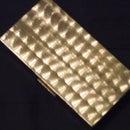Introduction: SPLICING BARBED WIRE SAFELY
Stretching, tightening and splicing barbed wire is a job that has to be done periodically. It's a dangerous job that must be done. The wire can slip, pulling the wire through your hands similar to a chain saw blade. Even punching your skin will require a tetanus shot. Tetanus is a serious bacterial infection that causes painful muscle spasms and can lead to death.
Step 1: THE OLD WAY OF SPLICING
Twisting the two ends together to make the splice is difficult and the rusty wire can lead to very serious injury even if you wear heavy leather gloves. These are some actual splices made probably 40 years ago or more.
Step 2: TOOLS & SUPPLIES NEEDED
TOOLS:
1 - Fence Stretcher......needed to pull the 2 wires together.
1 - Pair of fencing pliers......a multi-purpose tool. A hammer, pliers, wire cutter, staple puller all in one.
SUPPLIES:
1 - Flat washer w / 1/2" hole or a 1/2" nut to hold the 2 wires together
2 - 3/8" or 1/2" hex nuts to secure the ends of the wire.
Step 3: CUT WIRE & STRETCH IT
If the wire is not taunt, one solution is to cut the wire, remove some of it, and splice it back together.
Decide where you can cut and tighten the wire.
Using the stretchers, clamp the wire on each side of the spot you are going to cut.
Stretch the wire...........cut it.............
Remove barbs that are within 6" to the ends. Slip one nut onto each wire end.
Bend both ends to 90 degree angles.........
Stretch wire to get ends to touch .....
Step 4: FINISH BY SPLICING THE WIRE
Slip the washer over the 2 wire ends........
Bend wire ends back on themselves and back through the nuts. Bend 1/4" to 1/2" of the wire ends to keep the nuts from sliding off.
Remove fence stretcher.
In today's cattle country, good fences make good neighbors. You should now have one tight wire. Now all you have to do is tighten the other 3 or 4 wires. Contrary to what you see on old Gene Autry movies, barbed wire fences seldom come with less than 4 wires, or all the cattle would be out on the roadways and highways getting run into by you environmentally handicapped city drivers. LOL.......and we don't fight over using barbed wire or not using it.
Step 5: REVISION USING 1/2" PIPE
I made 2 revisions per suggestions in comments.
1.) I eliminated the washer and hooked the 2 ends together. This seems to be a better option.
2.) I cut some 1/2" copper pipe into 1/2" long pieces to replace the 1/2" nuts. This required a cutting tool and a grinding tool. I used a chop saw and an electric bench grinder and an electric motor with a wire wheel to remove the burrs. This may make the splice look nicer, but takes more tools, time, and planning. Steel pipe would have required the same preparation; I just didn't have any the right size.
It appears to me that grabbing a few 1/2" nuts, the fence pliers & fence stretcher before heading to the field is acceptable, but cutting the pipe, grinding it, de-burring it is not something you would normally do before getting on the 4 wheeler and going to the pasture, unless you were making the trip specifically to fix fence.

Participated in the
Brave the Elements Contest

Participated in the
Before and After Contest 2016











